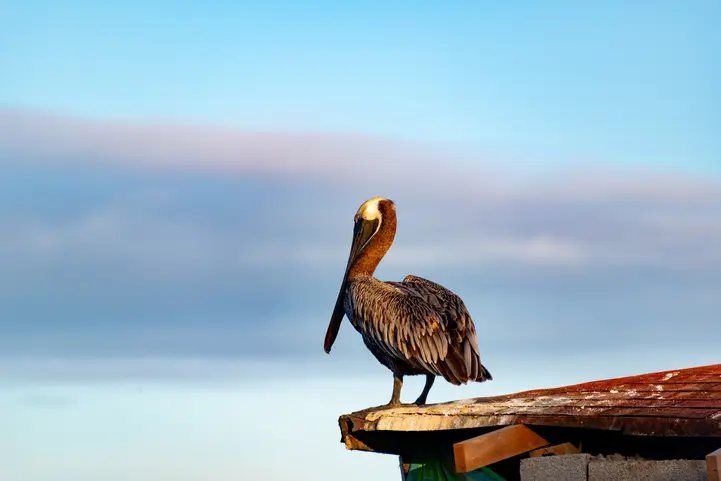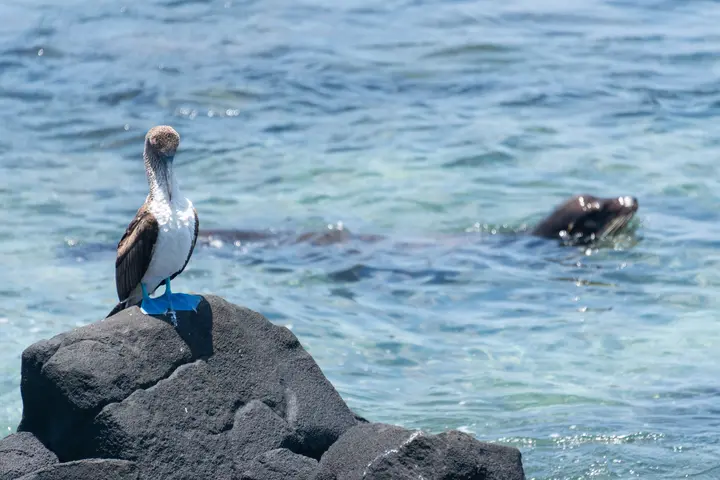Discover the majestic albatross: a guide to the soaring ocean giants

The seas and oceans are immersive and amazing environments that still keep many secrets and strange beings that are not well studied. One of these creatures is the majestic albatross, which is considered one of the greatest creatures in the high ocean world. If you want to learn more about this unique and strange being, this guide is the first step to discovering its secrets.
Show key points
- The majestic albatross originates from the Southern Pacific region and inhabits several oceans including the Atlantic, Indian, and Antarctic, often nesting on remote islands and rocky coastlines.
- Known for its grand wingspan and striking plumage, the albatross has evolved over millennia to develop exceptional flying and fishing capabilities suited to oceanic life.
- Albatrosses demonstrate remarkable cooperative behavior, hunting in large synchronized groups to effectively trap and capture fish.
- ADVERTISEMENT
- This oceanic bird possesses extraordinary sensory abilities, such as sharp vision and a keen sense of smell and hearing, which aid in locating prey over vast distances.
- Despite their natural resilience, albatross populations are threatened by habitat loss, pollution, and climate change, necessitating urgent conservation efforts.
- Global initiatives, including protected zones and continued scientific research, aim to safeguard the future of the albatross and maintain its ecological role.
- Studying the majestic albatross not only unveils the mysteries of its unique lifestyle but also reinforces the importance of preserving biodiversity in marine ecosystems.
1. The origin of the majestic albatross and its geographical presence

The origin and geographical presence of the majestic albatross is of great interest to marine biologists and animal lovers. Have you ever wondered about the source of this wondrous creature and its areas of presence?Let's discover the origin of the majestic albatross and its presence in the world.
Recommend
According to scientific studies, the majestic albatross is believed to have originated in the Southern Pacific Ocean and adjacent areas, such as those near the Australian and New Zealand coasts. There is also a presence of the majestic albatross in the Atlantic, Indian and Antarctic Oceans.
The majestic albatrosses are an integral part of the ecosystems of these areas, living on remote islands, rocky heights and deep marine areas. He prefers life in cold waters and areas that provide him with food and ideal conditions for reproduction.
Due to its geographical presence, the majestic albatross is characterized by its variety of species and its presence in specific areas. For example, the Arctic albatross can be seen in the Arctic, while the Royal Albatross lives on the islands of New Zealand and the violet Albatross in South Australia and New Zealand.
The reasons why the majestic albatross is present in these areas remain under research and exploration. However, it is important that we go to and protect these areas to preserve the existence of this unique creature and ensure the continuity of its life in its natural environment.
2. The majestic appearance of the albatross and its wondrous adaptations

Majestic albatrosses are distinguished by their unique and attractive appearance that amazes everyone who watches them. It is considered one of the most luxurious and beautiful creatures in the high ocean world. The majestic albatross bears a large head with a strong, sharp beak that can easily open fish. It is also characterized by wide eyes that give it the ability to clearly see its prey even in deep water.
As for its body, it is characterized by its feathers, which range in color from black to white, yellow and brown, giving it a breathtaking aesthetic ripples. The majestic albatross is between 1.5 and 2.5 meters long, making it among the greatest creatures in the high ocean world. Its agile structure has been developed over the ages to adapt it to the aviation and fishing life of the ocean.
The majestic albatrosses' adaptations don't stop there, as hundreds of thousands of years have developed amazing, convex wings that enable it to fly long distances and at high speeds. Thanks to its robust wings structure and long feet, the majestic albatross can fly through the sky for long periods of time without stopping, making it among the best migratory birds required for beautiful visibility and enchanting aerial performance.
In addition to the strength of its long wings and feet, the majestic albatross relies on ocean-going birds to help it catch fish. It collaborates with these tiny birds to guide it to fish gathering places, often near the surface of the ocean, where the majestic albatrosses can easily catch their prey. This wondrous adaptation plays a crucial role in the survival and nutrition of the majestic albatross.
The majestic albatross is a symbol of beauty and power in the high ocean world. His wondrous adaptations allow him to fly quickly and for long periods and enable him to fish efficiently. It is a unique object that combines elegance and grandeur, and seeing this magnificent object will undoubtedly be an unforgettable experience.
3. The behavior of the majestic albatross: fishing and mass spread

It is interesting that the majestic albatross is considered one of the strongest predators in the seas and oceans, as it feeds on fish in an amazing and creative way that deserves admiration.
When the albatross is in hunting mode, it shows off its unique and amazing skills. He sets out of the sky with great skill and speed, then dives into the water with amazing force to capture his prey. He uses his long, sharp beak to capture fish with great precision, and has the ability to control his underwater movements with incredible dexterity.
But what makes the behavior of the majestic albatross really amazing is its mass spread. Albatrosses are formed in huge groups exceeding hundreds or even thousands of birds. These groups work harmoniously and in coordination for hunting, with birds working together to puzzle the fish and group them in a specific location. Birds cooperate in making a freely "net" using their bodies to catch fish and make sure they do not escape.
This collective strategy for catching albatrosses is ideal for achieving the highest level of efficiency and success in hunting. Not only that, but this collective behavior provides additional protection for birds against potential attacks by predators. The ability of the majestic albatross to cooperate in fishing demonstrates the high level of sophistication and intelligence of this creature.
The unique behavior of the albatrosses reminds us of the importance of teamwork and cooperation in success and survival. Although the bird may be strong on its own, it relies on the support of its colleagues to achieve the highest level of efficiency in its hunting. Therefore, we must be inspired by the behavior of the great albatross and work in a spirit of cooperation and prejudice to achieve our common goals and success in various aspects of our lives.
4. The superior sensory abilities of the majestic albatross

The majestic albatross is a strong creature that can stay in the air for long periods and fly with high elegance and mastery. Behind these amazing abilities lies his superior sensory abilities that make him a leader in the high ocean world. So what are those abilities and how do they help the majestic albatross succeed in its harsh environment?
One of the most important abilities of the albatrosses is the wonderful sense of sight that allows it to see far and sharp even in foggy and dark conditions. This bird has very convenient eyes, as it has special lenses that can better focus light on the retina, allowing it to clearly see prey and obstacles at a distance. Therefore, it relies on its sharp eyesight to identify fish and their fisheries.
In addition to their strong sense of sight, albatrosses have other superior sensory abilities, such as smell and hearing. The shape of his erect cone-like nose and large size are a major reason for his strong sense of smell, enabling him to detect odors in the air and locate potential fish and fisheries in the water. As for his sense of hearing, he is found in side holes on his neck that allow him to listen to sounds under the surface of the water and recognize the movements of fish and even other birds.
Thanks to these superior sensory abilities, the albatross can distinguish sounds and smells even from great distances, which contributes significantly to its success in catching fish. He relies on these abilities to fly accurately and quickly towards his prey, exploiting weathering and visual and auditory indicators to determine the perfect moment to jump and catch fish with his powerful beak.
There is no doubt that the majestic albatross's superior sensory abilities play a big role in its success in its harsh environment. Understanding and contemplating these abilities truly reflects the greatness of this being and its ingenious adaptation to the world of the high ocean.
5. Protection of the majestic albatross and its present-day condition

The majestic albatrosses deserve respect and protection, as they are among the unique and rare creatures that adorn the deep oceans. As threats to the marine environment increase, the protection of the majestic albatross has become a matter of paramount importance.
The habitat decline of the majestic albatross and the loss of breeding sites are the main things it faces. As a result, the number of individuals found in nature has declined significantly over the past decades, making them vulnerable to extinction. Poor environmental conditions, pollution, overhunting, and climate change are some of the factors threatening the state of the majestic albatrosses nowadays.
Many environmental organizations and global governments have taken action to protect this unique creature and maintain its survival in the seas and oceans. Establishing protection zones and identifying key breeding sites is ideal for maintaining the life and breeding of the majestic albatross. In addition, public awareness and education on the importance of preserving this organism has become an essential part of protection efforts.
Many scientific studies and research also analyze the state of the majestic albatross at present. The number of individuals is monitored, the threats they face are assessed, and the state of the environment around them is tracked. This valuable scientific knowledge contributes to the identification of sustainable protection actions and the promotion of conservation efforts.
Despite the challenges faced by the majestic albatross, there is still hope to protect this beautiful and noble creature. It requires intensified efforts to raise awareness and preserve its natural environment, strictly implement protective measures, and cooperate with States and international groups to preserve this great creature and provide it with a safe and sustainable environment. Protecting the majestic albatross is our collective duty to preserve the diversity of life in the oceans, seas and for future generations.

The study of the majestic albatross is a real challenge for biologists and marine life enthusiasts, as this strange creature holds many mysteries and secrets to be revealed. With the passage of time and increased research efforts, we hope to be able to better protect this magnificent creature and maintain its survival in the world's seas and oceans. Based on the knowledge gathered about the majestic albatross, we can look forward to further discoveries and understanding about this creature that deserves respect and admiration.








